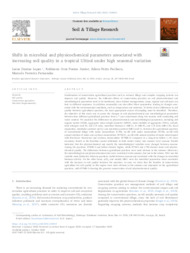Shifts in microbial and physicochemical parameters associated with increasing soil quality in a tropical Ultisol under high seasonal variation.
Shifts in microbial and physicochemical parameters associated with increasing soil quality in a tropical Ultisol under high seasonal variation.
Autoria: LOPES, L. D.; FONTES JUNIOR, R. C.; PACHECO, E. P.; FERNANDES, M. F.
Resumo: Combination of conservation agricultural practices such as reduced tillage and complex cropping systems can improve soil quality. However, the different effects of conservation practices on soil physicochemical and microbiological parameters need to be monitored, since distinct managements, crops, regions and soil types can lead to different responses. In addition, seasonality can also affect these parameters, leading to changes associated with the environmental conditions, such as temperature and moisture. To better detect differences in soil quality between agricultural practices, the most appropriate season of sampling must be identified. Therefore, the objective of this study was to assess the changes in soil physicochemical and microbiological parameters between four different agricultural practices from a 7-year experiment along two seasons with contrasting soil water content. We analyzed the differences in physicochemical and microbiological parameters, including soil organic matter (SOM), aggregates mean weight diameter (MWD), water stability of aggregates (WSA), soil pH, total nitrogen (soil N), soil C:N ratio, microbial biomass-C (MB-C), N (MB-N), and C:N ratio (MB-C:N), basal respiration, metabolic quotient (qCO2) and microbial quotient (MB-C:soil C), between the agricultural practices of conventional tillage with maize monoculture (CTM), no-till with maize monoculture (NTM), no-till with annual rotation of maize and soybean monoculture (NTM/S), no-till with annual rotation of maize intercropped with Brachiaria rhuziziensis and soybean monoculture (NTMB/S) compared to a long-term fallow (>40 years secondary forest) at the Brazilian coastal tablelands in both winter (rainy) and summer (dry) seasons. Results indicated that the physicochemical and mostly the microbiological variables were changed between seasons. Among the practices, NTMB/S and fallow showed higher, while NTM/S and CTM showed lower soil physicochemical quality. The differences between agricultural practices were most obvious in the summer. Moreover, the microbiological and physicochemical data were correlated in the summer, but not in the winter. WSA was the variable most distinctive between practices, stable between seasons and correlated with the changes in microbial biomass/activity. On the other hand, qCO2 and mainly MB-C were the microbial parameters more associated with the increase in soil quality between the practices. In sum, we show that the benefits of conservation agriculture for soil quality in this region were most obvious in the summer and depended on the agricultural practices, with NTMB/S showing the greatest conservation of soil physicochemical quality
Ano de publicação: 2021
Tipo de publicação: Artigo de periódico
Unidade: Embrapa Tabuleiros Costeiros
Palavras-chave: Argissolos, Microbial activity, Microbiologia do Solo, Sistema de Cultivo, Soil
Observações
1 - Por padrão são exibidas publicações dos últimos 20 anos. Para encontrar publicações mais antigas, configure o filtro ano de publicação, colocando o ano a partir do qual você deseja encontrar publicações. O filtro está na coluna da esquerda na busca acima.
2 - Para ler algumas publicações da Embrapa (apenas as que estão em formato ePub), é necessário ter, no celular ou computador, um desses softwares gratuitos. Sistemas Android: Google Play Livros; IOS: iBooks; Windows e Linux: software Calibre.
Acesse outras publicações
Acesse a Base de Dados da Pesquisa Agropecuária (BDPA) para consultar o acervo completo das bibliotecas da Embrapa.

